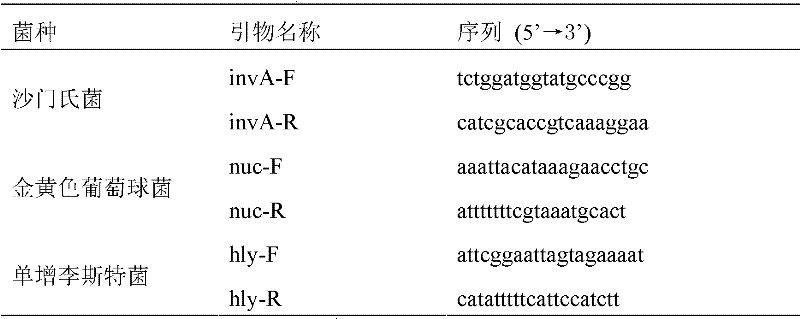Multiple rapid detection method, detection primer group and kit for three food-borne pathogenic bacteria
A rapid technology for detection of primers, applied in the field of microbial detection, can solve problems such as inability to identify multiple pathogenic bacteria, and achieve the effects of optimization of the LAMP reaction system, strong specificity, and optimized reaction conditions
- Summary
- Abstract
- Description
- Claims
- Application Information
AI Technical Summary
Problems solved by technology
Method used
Image
Examples
Embodiment 1
[0029] Embodiment 1: Optimum Mg in the LAMP reaction system of triple LAMP rapid detection method of the present invention 2+ Determination of concentration.
[0030] The specific determination method of this embodiment is:
[0031] 1. Extraction of sample DNA
[0032] 11 Inoculate the standard strains of Salmonella and Staphylococcus aureus in nutrient broth respectively, inoculate Listeria monocytogenes in brain heart infusion broth, and incubate at 36°C±1°C for 18 hours.
[0033] 1.2 Use the QIAGEN Bacterial Genomic DNA Extraction Kit to extract the bacterial DNA in the above cultured products respectively.
[0034] 2. LAMP reaction
[0035] 2.1 Artificially synthesized primer sets for the detection of Salmonella, Staphylococcus aureus and Listeria monocytogenes respectively. Wherein, the upstream primer of the outer primer used in the primer set for Salmonella detection has a sequence as shown in SEQ No.1, the downstream primer of the outer primer has a sequence as sho...
Embodiment 2
[0050] Example 2: Determination of the optimal LAMP reaction temperature of the triple LAMP rapid detection method of the present invention.
[0051] The specific determination steps of this embodiment are as follows:
[0052] 1. Extraction of sample DNA
[0053] 1.1 Inoculate the standard strains of Salmonella and Staphylococcus aureus in the nutrient broth respectively, inoculate the Listeria monocytogenes in the brain heart infusion broth, and incubate at 36°C±1°C for 18 hours.
[0054] 1.2 Use the QIAGEN Bacterial Genomic DNA Extraction Kit to extract the bacterial DNA in the above cultured products respectively.
[0055] 2. LAMP reaction
[0056] 2.1 Artificially synthesize primer sets for the detection of Salmonella, Staphylococcus aureus and Listeria monocytogenes respectively, and the primers and sequences of each primer set are consistent with those described in Section 2.1 of Example 1.
[0057] 2.2 LAMP reaction system
[0058] 2.2.1 LAMP reaction system of Salm...
Embodiment 3
[0071] Example 3: The detection sensitivity of the triple LAMP rapid detection method of the present invention to Salmonella.
[0072] The concrete detection method of the present embodiment is:
[0073] 1. Extraction of sample DNA
[0074] 1.1 Inoculate the standard strain of Salmonella in nutrient broth and incubate at 36°C±1°C for 18 hours.
[0075] 1.2 Use the QIAGEN Bacterial Genomic DNA Extraction Kit to extract the bacterial DNA in the above cultured products.
[0076] 2. LAMP reaction
[0077] 2.1 Artificially synthesize primer sets for the detection of Salmonella, Staphylococcus aureus and Listeria monocytogenes respectively, and the primers and sequences of each primer set are consistent with those described in Section 2.1 of Example 1.
[0078] 2.2 Reaction system of LAMP
[0079]Set up 9 reaction tubes, the total volume of the reaction system in each reaction tube is 25 μL, including: the upstream primer and downstream primer of the external primers for the det...
PUM
 Login to View More
Login to View More Abstract
Description
Claims
Application Information
 Login to View More
Login to View More - R&D
- Intellectual Property
- Life Sciences
- Materials
- Tech Scout
- Unparalleled Data Quality
- Higher Quality Content
- 60% Fewer Hallucinations
Browse by: Latest US Patents, China's latest patents, Technical Efficacy Thesaurus, Application Domain, Technology Topic, Popular Technical Reports.
© 2025 PatSnap. All rights reserved.Legal|Privacy policy|Modern Slavery Act Transparency Statement|Sitemap|About US| Contact US: help@patsnap.com

